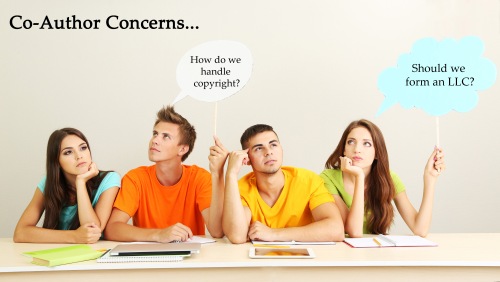
Jessica Parker Senior
Publishing Consultant
Oftentimes authors decide that they want to co-author a work, publish a compilation of works from multiple authors, or have contributors to their work. What authors fail to consider when embarking on this path is the copyright. Multi-author books can be complicated when it comes to filing the copyright, and there are a few things you should consider before getting too far along in the process. When filing copyright for a book, it is required that all authors be listed on the application. Yup, that’s right, folks, all authors. This means that if you have seven authors who contributed chapters to your book, each of these authors will need to be listed on the application except in the case of a work-for-hire.
There are two important areas of the copyright application that should be noted. One is the author section, and the other is the claimant section. The author is who created any part of the text, editing, photos, illustrations, etc. When listing each author on the application, you will need to specify what exactly they created within the work (text, illustrations, photos, graphics, etc.). Most authors never even consider that their photographer would need to be listed as an author! However, it is true unless you have the appropriate documents signed. The claimant is the one who owns the exclusive world rights to the material covered under the application. If you did not author the entire work, you cannot legally lay claim to the rights of the entire work unless you have done your legal legwork. Below I have summarized the two basic scenarios that you are looking at when it comes to filing a multi-author work.
There are many loopholes and exceptions to these, but these should give you a good idea of which is right for you and what you’ll need in order to achieve it. Scenario 1: Co-authors/Single claimant In this scenario, you could have multiple authors, but only one claimant. In order for this to be done correctly, you would need each author to sign a transfer of rights form in which they are transferring their rights of what they contributed to the work to a single person. If each author signs a transfer of rights, then the person who they transferred the rights to would be the sole owner of the copyright. This means that the contributing authors have no rights over the book or the material they contributed.
Scenario 2: Co-authors/Co-claimants In this scenario, all of the contributing authors would be listed as authors and claimants on the application. This means that each author would have equal rights over the book as a whole, and could create derivative works, second editions, print it, etc. without asking permission of the other claimants. These are the two basic scenarios that you are looking at when it comes to multi-author texts. Depending on the rights you want your co-authors to have, this will determine which scenario is best for you. Either way, it is advisable to work out these details prior to approaching a publishing company. You may also need to have agreements with each individual author stating rights they have over the book, royalties they will receive, etc. in either of these scenarios. This way each author knows what they can and cannot do and what they will or will not receive.






